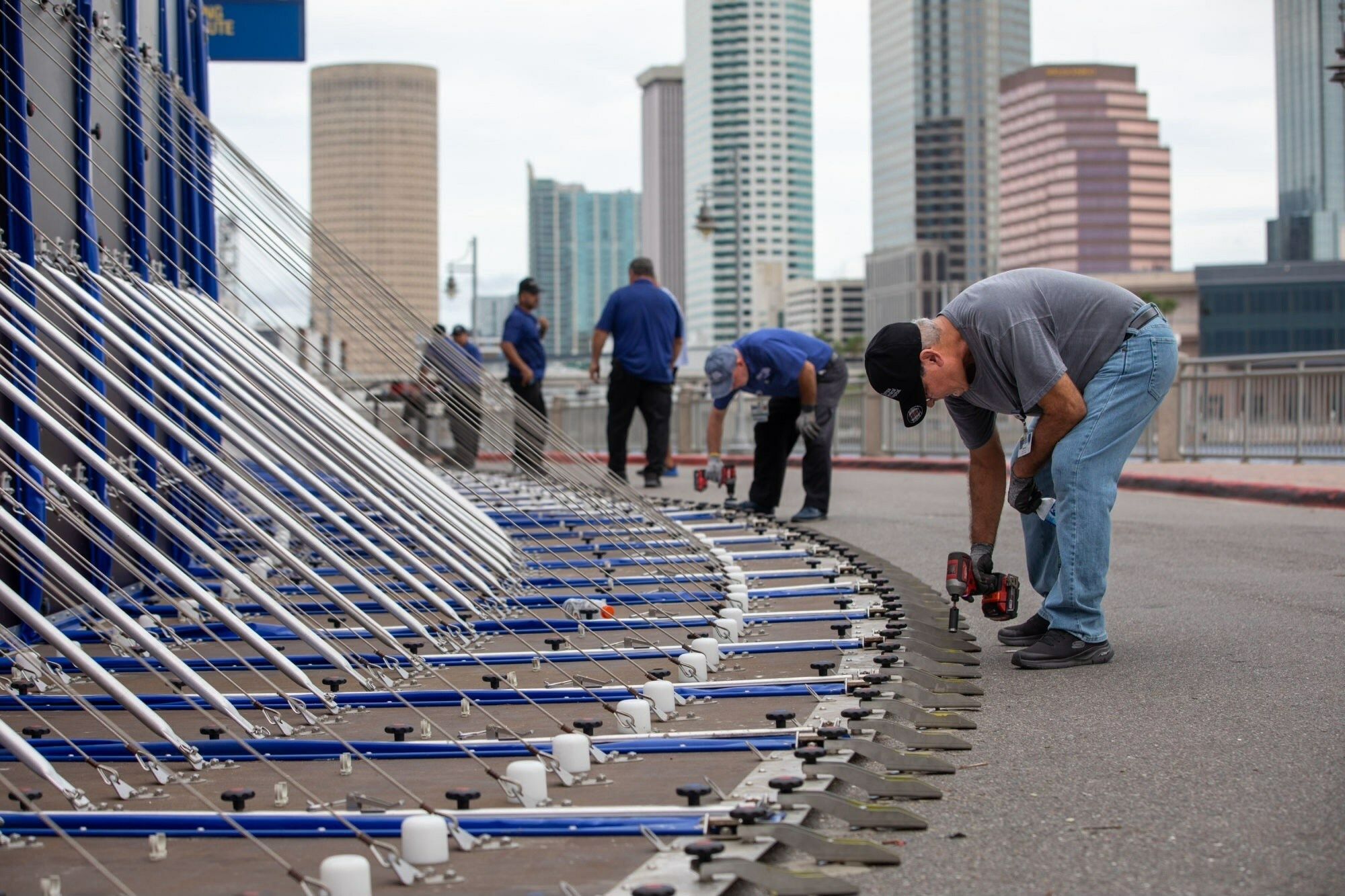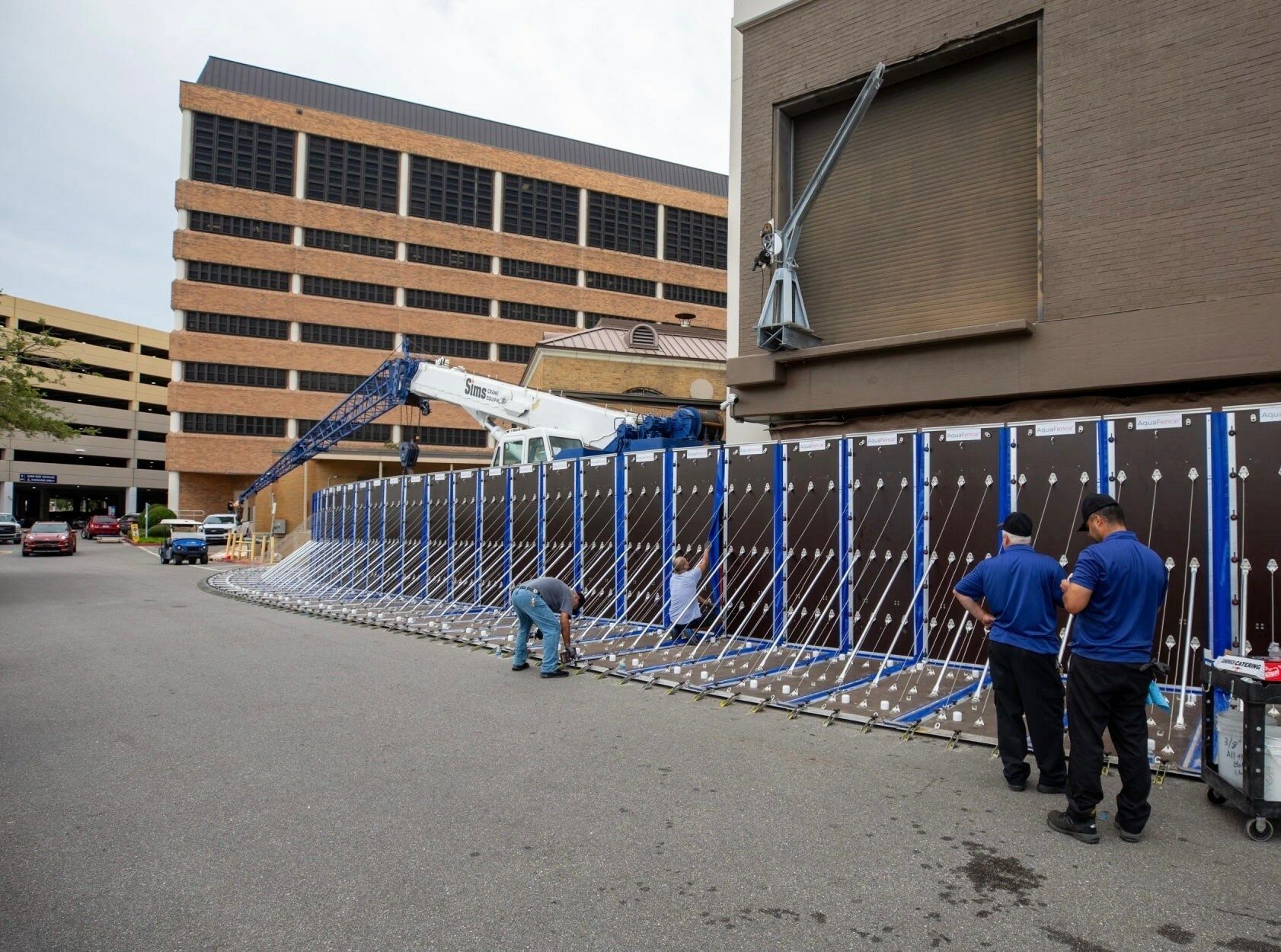Preparing for hurricanes and severe weather: Lessons from Tampa General Hospital
The large hospital avoided damage from Hurricane Idalia. The organization has developed detailed plans to deal with flooding, power losses and other disruptions from storms.
Sitting on an island in Hillsborough Bay, Tampa General Hospital has had to develop a thick playbook for dealing with hurricanes, flooding and damage from powerful storms.
Tampa General Hospital installed the AquaFence barrier around the medical center ahead of Hurricane Idalia. The hospital has extensive plans for dealing with storms. (Photo: Tampa General Hospital)

The hospital, which has more than 1,000 beds, utilized a temporary barrier from AquaFence during Hurricane Idalia just over a week ago. While the hurricane did more damage further north, Tampa Bay and surrounding communities saw some flooding, but Tampa General’s fences prevented serious issues. The AquaFence barrier is designed to prevent surges of up to 15 feet above sea level.
Dustin Pasteur, Tampa General’s vice president of facilities and construction, breathed a sigh of relief that Idalia didn’t deliver a serious blow to the hospital. Typically, he prefers to have three days to set up the fencing and other flood protection measures, but they only had two days with Idalia.
“It was tough,” he tells Chief Healthcare Executive®. “It took a lot of long hours to get it up.”
Pasteur said the hospital made the decision to start installing the fence when Idalia was still “a weak tropical storm with an uncertain path.”
“But we knew that it only had a couple of days to get to us and we had to get started,” Pasteur says. “And ultimately we just had enough time.”
In an interview with Chief Healthcare Executive, Pasteur talks about planning for Idalia, the hospital’s plans for storms and severe weather, and he shares insights for other health systems in preparing for weather emergencies.
Idalia and Ian
Hurricanes can strike along the Atlantic from June through November, according to the National Weather Service. In Tampa, the peak of hurricane season typically runs from late August through early October.
Tampa General Hospitals set up the AquaFence barrier ahead of Hurricane Idalia. Part of the fence will remain up through October. (Photo: Tampa General Hospital)

When heavy storms have potential to hit the Tampa area, Pasteur says the hospital aims to discharge as many people as possible. With Idalia, the hospital still had around 900 patients, “which is a huge amount,” Pasteur says.
As storms begin to develop, Tampa General begins preparations for serious weather four days before the expected landfall, Pasteur says.
“If the path is uncertain and we're anywhere near the cone, then we just have to proceed as if we're going to get that storm, which is exactly what we had to do with Idalia,” he says.
A year ago, Hurricane Ian demonstrated the unpredictable path of these powerful storms. Ian looked to be headed directly at the Tampa area, but with a late shift in direction, the hurricane moved south and hit the Fort Myers area.
While Idalia dealt a blow to Florida’s Big Bend, Ian moved much more slowly and did far more damage to the more populous Fort Myers region. In the end, Hurricane Ian claimed 149 lives and produced heavy damage, including to some healthcare facilities.
Pasteur called Ian the most challenging event he has encountered in his 14 years at Tampa General.
“We ultimately didn't get a lot of impact from that storm,” he says. “But the severity of it, and the fact that we were going to have a direct hit until the very last minute, was very stressful. It took a lot of prep.”
After Idalia, the hospital only removed part of the AquaFence barrier. Part of the fence will remain standing into October, Pasteur says.
Redundancy is key
When asked for key lessons for other hospitals in preparing for hurricanes or other severe weather events, Pasteur cited one word repeatedly: Redundancy.
Hospitals need to do more than have a plan to preserve critical systems. They need to have a contingency if that plan doesn’t work.
“I think redundancy is the key,” Pasteur says. “Redundancy in all systems.”
“There's things people don't think about like water or sewage, air conditioning, of course, food, all of these things … You might have a plan, but what happens if that plan doesn't succeed? What's your backup? So we try to build in all kinds of levels of redundancy.”
In addition to the AquaFence, Tampa General Hospital has detailed plans for delivery of fuel and other key supplies in a hurricane. (Photo: Tampa General Hospital)

In advance of a major storm, Tampa General brings in enough extra water to supply the hospital for five days, he says. Tampa General recently finished building an emergency well, so that water can be pulled from the ground, treated through reverse osmosis, and used to supply the hospital. “But we're still going to bring the bottled water,” Pasteur says.
Tampa General also has contingency plans with state and local fire officials to have pumper trucks provide additional water for the hospital’s sprinkler system.
For Idalia, some medications, such as specialty drugs that need to be kept at cold temperatures, were moved from off-site locations to areas that have generators.
The hospital has also formed agreements to deliver fuel in the event of heavy flooding. If nearby bridges are washed out, Tampa General has a supplier that can bring some fuel via helicopter, and the hospital also has an agreement with a nearby port for fuel to be shipped via water.
Tampa General has generators that run on fuel, and other generators that run on natural gas. If there’s an interruption in the fuel supply, the hospital can still maintain power from generators on natural gas.
The hospital maintains a permanent storage site for supplies in the event of hurricanes and other storms. The facility is stocked with PPE and other essential supplies. After COVID-19 arrived, Tampa General converted another warehouse into a storage site for pandemic supplies.
“We always have our pandemic supplies and our hurricane supplies ready to go,” Pasteur says. “So we're not relying on deliveries at the time that you need them. We already have them.”
Forming partnerships
Pasteur emphasized the importance of establishing agreements with other community organizations and businesses for assistance in emergencies. The city of Tampa has agreed to allow the hospital to use the convention center for a base if needed; the convention center sits across the channel from Tampa General.
In addition, Tampa General has formed agreements with ferries and water taxis to assist the hospital after a severe storm. Potentially, the ferries could be used to provide transportation, or even assistance with kitchen services or places to sleep if needed.
“Having all these agreements is a big part of being resilient,” Pasteur says.
Hospitals should talk regularly with local, county and state governments on disaster planning. Ahead of a storm, health systems should reach out early to their local governments if they anticipate a weather event is going to disrupt services.
“It’s important if you're going to be doing anything that's not the standard of practice because of a storm, if you're expecting that you're going to alter the way that you function because you might have reduced capacity from a storm, you should run that by your authorities,” Pasteur says.
In the end, hospitals and health systems need to think critically about maintaining services in emergencies, including planning for the worst-case scenario.
“You've got to have these layers of plans and then think about each stage of your plan,” Pasteur says. “If that fails, what do you do? And if you don't have an answer, then you should figure one out until you've run down all of those questions and you have an answer for all of them.”
Pasteur is a Florida native, and generations of his family have lived in the Sunshine State. Tampa General has invested heavily - in time and dollars - to prepare for severe storms.
Still, Pasteur says he still feels the stress on the cusp of a hurricane.
“The reality is that these are forces that we can't control,” he says. “So we have to protect the best we can. And we put in every implementation of safety that we can, but we have to know that ultimately, whatever's coming to us, we can't control it. And so there's always anxiety around that.”
Telehealth faces a looming deadline in Washington | Healthy Bottom Line podcast
February 12th 2025Once again, the clock is ticking on waivers for telemedicine and hospital-at-home programs. Kyle Zebley of the American Telemedicine Association talks about the push on Congress and the White House.